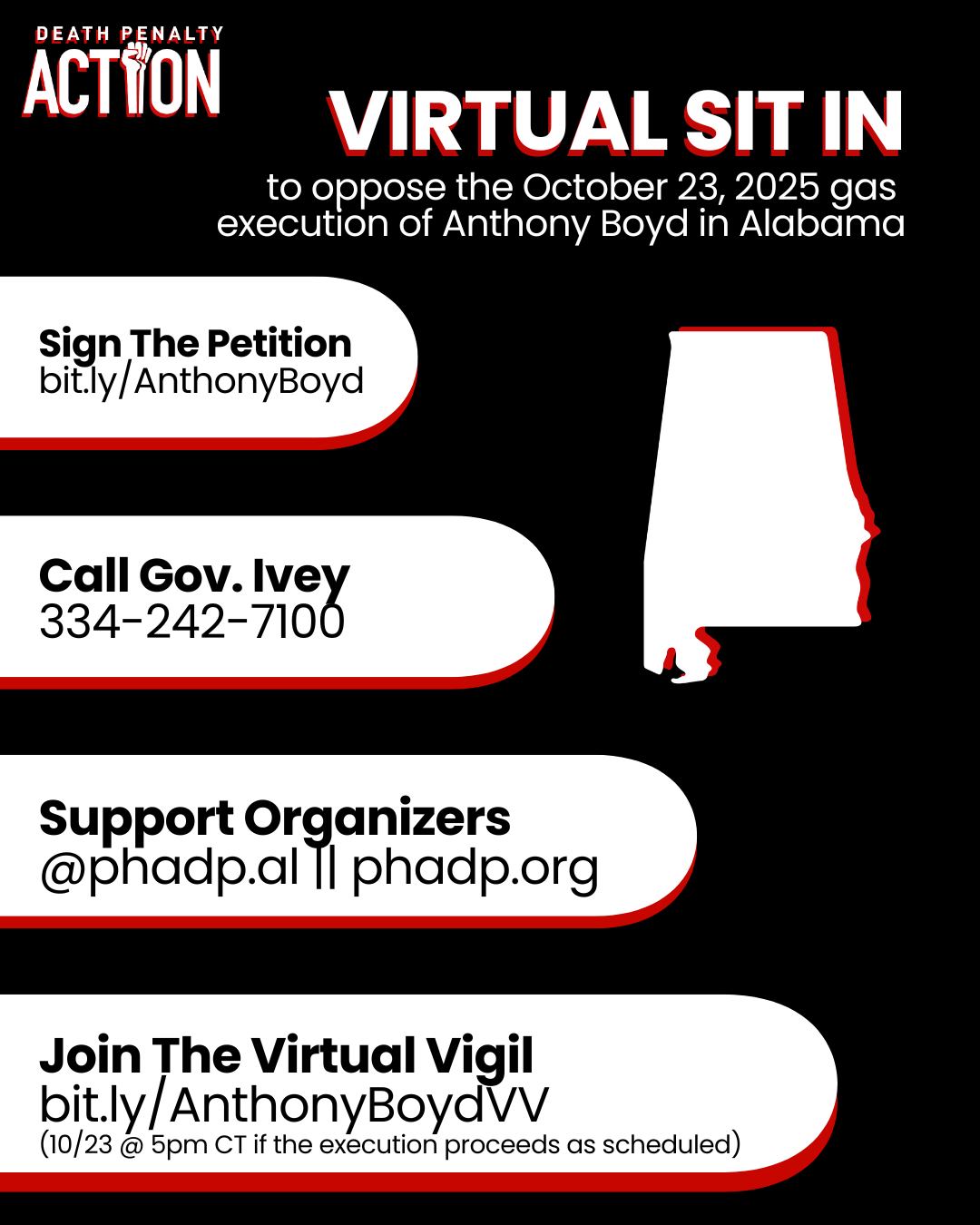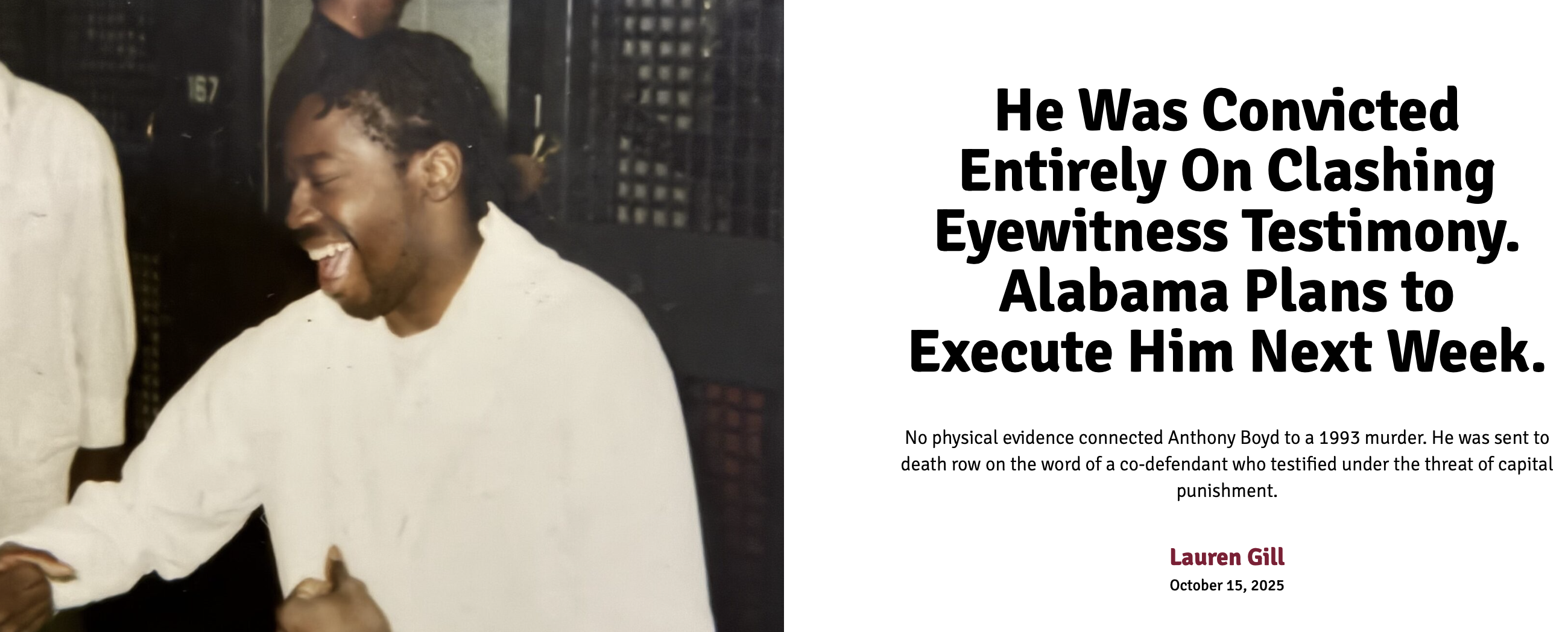Stop the Execution of Anthony Boyd in Alabama
Governor Kay Ivey
.png)
Anthony Boyd is scheduled for execution in Alabama on October 23, 2025 for his alleged role in the 1993 murder of Gregory Huguley.
READ: Anthony Boyd Is Innocent: The Extended Case
READ: This extensive article Lauren Gill in Bolts Magazine
Additional case details are below.
Join the Virtual Sit In
Call Gov. Ivey at 334-242-7100 with the following message:
"Hi. My name is [your name]. I am calling to express deep concern that the state of Alabama is gearing up to execute Anthony Boyd October 23 despite numerous questions about guilt in his case. We commend you for the courageous act you took earlier this year when you granted Rocky Myers relief and urge you to take a meaningful look at Anthony Boyd's case, too. The issues in Mr. Boyd's case stem from ineffective trial counsel who failed to conduct pretrial investigations of state witnesses and failed to present forensic expert testimony challenging the state's assertion. Thank you."
Register for the Live Virtual Vigil here.
If carried out, it would be yet another execution by nitrogen gas, a method Alabama began using last year as an alternative to lethal injection.
While the vast majority of states with capital punishment continue on a downward trend of executions, Alabama has continued to go against trend by carrying on with scheduled execution dates. Additionally, the State of Alabama has repeatedly shown blatant incompetence in carrying out executions - they need to pause ALL executions to allow for meaningful review of their protocols.
Concerns in Mr. Boyd's case:
1. Reliance on Incentivized Witness Testimony
The prosecution’s case against Anthony Boyd depended almost entirely on the testimonies of co-defendants who had entered plea agreements in exchange for cooperation. These witnesses were facing serious criminal charges themselves, giving them a strong incentive to provide statements favorable to the prosecution. For example, one co-defendant testified that Boyd taped the victim’s feet while another handled the victim’s hands and mouth (Boyd v. State, 715 So. 2d 825, 828). Another witness described the victim pleading for his life. While emotionally compelling, these accounts were never corroborated by forensic evidence or other independent proof. This reliance on self-interested witnesses creates a high risk of false testimony, as the credibility of these individuals was directly linked to the personal benefit they would receive. Supreme Court precedent reinforces this concern: Napue v. Illinois (1959) and Giglio v. United States (1972) establish that convictions based on false or incentivized testimony violate due process, particularly in capital cases. In Boyd’s trial, although the jury was informed of the plea deals, the overwhelming narrative constructed by the prosecution limited the defense’s ability to effectively cross-examine and challenge these witnesses, increasing the risk of wrongful conviction.
2. Absence of Forensic Corroboration
A critical flaw in Boyd’s trial was the near-total absence of forensic evidence linking him to the crime. The State’s own latent print expert confirmed that no fingerprints were found from Boyd, his co-defendants, or others charged in the case (Boyd v. State, 715 So. 2d at 832). Beyond fingerprints, no DNA, fibers, or other trace materials tied him to the crime scene, the vehicle allegedly used, or the tools involved. Forensic evidence is particularly important when eyewitness accounts are contested or potentially biased, because it provides objective verification. Moreover, the defense did not thoroughly investigate the rental van central to the prosecution’s narrative, missing an opportunity to corroborate—or disprove—the timeline and presence of Boyd. Without such evidence, the conviction rests solely on testimonial accounts from potentially biased witnesses, which fails to meet the constitutional standard established in Jackson v. Virginia (1979), requiring that evidence must be sufficient for any rational trier of fact to find guilt beyond a reasonable doubt. The absence of forensic corroboration renders the conviction highly unreliable.
3. Marginalized or Excluded Exculpatory Evidence
Several pieces of evidence that could have exonerated Boyd were ignored or excluded. First, multiple alibi witnesses testified that Boyd was at social gatherings during the time of the crime. For instance, Ms. Willie Watson saw him at a party around 10:00–11:00 p.m., and Catherine Jones confirmed his presence at the same time (Boyd v. State, 715 So. 2d at 833). These witnesses had no apparent motive to lie, but their testimony was marginalized in favor of the more dramatic accounts from co-defendants. Second, Sharon Bush, a key witness who originally implicated Boyd, later signed a recantation stating that her trial testimony was false and coerced. She claimed law enforcement pressured her to testify, promising leniency in unrelated cases if she cooperated. The courts ruled this recantation inadmissible due to procedural timing rules, not because of factual unreliability. Supreme Court precedents such as Chambers v. Mississippi (1973) and Brady v. Maryland (1963) emphasize the constitutional importance of allowing defendants to present witnesses and evidence that could create reasonable doubt. By excluding or minimizing these exculpatory accounts, the trial effectively insulated the State’s narrative from scrutiny, undermining both fairness and the reliability of the conviction.
4. Overreliance on Hearsay and Emotionally Charged Narrative Evidence
Boyd’s conviction was further compromised by the trial’s reliance on hearsay and emotionally charged statements, admitted under exceptions like “spontaneous utterance” or “res gestae.” While technically admissible, such statements risk conflating emotional impact with probative value. Witnesses described the victim pleading for his life and the violent details of the crime, creating a powerful narrative that may have influenced the jury more than objective evidence. The Supreme Court has consistently warned that capital convictions must not be based primarily on emotional resonance rather than verified facts (Darden v. Wainwright, 1986). In Boyd’s trial, these narratives were reinforced by co-defendant testimony and the absence of independent verification, constructing a story of guilt that, while persuasive, lacked factual substantiation. The cumulative effect of hearsay and narrative evidence created a misleading picture of culpability, violating constitutional protections that require proof beyond a reasonable doubt (Jackson v. Virginia, 1979; In re Winship, 1970). This overreliance on narrative and emotion, rather than verifiable fact, is a central argument for Boyd’s innocence.
Addition points from Project Hope to Abolish the Death Penalty.
1. Mr. Boyd is innocent but was found guilty due to ineffective assistance of counsel who failed to conduct reasonable substantial pretrial investigations of state witnesses and of their agreement with the state and of alleged eyewitnesses; also, failure to present forensic science expert testimony, expert pathologists and eye witness identification which would have nullified all so called incriminating evidence. Details are spelled out here.
2. By failing to interview state witnesses prior to trial effective cross examination was impossible.
3. There is a lack of scientific evidence supporting the use of nitrogen gas for human execution, and the American Veterinary Medical Association advises against its use for most mammals because it can cause panic and distress. We continue to condemn the use of nitrogen hypoxia – it is neither quick nor painless and we believe it constitutes torture or at the least amounts to cruel and unusual punishment which is barred by the U.S. Constitution.
4. Alabama has a duty to carry out executions under the protection of the U.S. Constitution. For this reason we believe there should be a stay of executions to allow for a thorough study of the state's capital punishment practices in light of the serious objections raised over how it administers the death penalty.
Additional Information and Action Opportunities Regarding Alabama Executions
- Click here for information about Gas Suffocation Executions
- Click here for The Pull Back The Curtains Campaign to Demand Full Transparency in Alabama Executions
Sponsored by
To:
Governor Kay Ivey
From:
[Your Name]
In light of the scheduled October 23, 2025 execution of Anthony Boyd, we urge a halt to all executions in Alabama.
The execution method to be used, nitrogen gas asphyxiation, is neither quick nor painless, but agonizing and painful as was demonstrated at the executions last year. It amounts to cruel and unusual punishment which is barred by the U.S. Constitution.
Alabama ought to delay all executions to allow for a thorough study of its capital punishment process and consider the serious objections raised as to how it administers the death penalty. Alabama has repeatedly shown that it is not capable of carrying out executions, as it is botching its lethal injection process - amounting to cruel punishment and the torture of prisoners.
The vast majority of states with capital punishment continue on a downward trend of executions, Alabama has continued to go against trend by carrying on with scheduled execution dates.
We, the undersigned, ask that you do everything within your power to stop all executions in Alabama.
Thank you for your time and attention to this serious matter.

